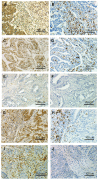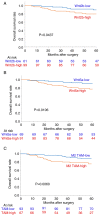Wnt2b and Wnt5a expression is highly associated with M2 TAMs in non‑small cell lung cancer
- PMID: 36102318
- PMCID: PMC9500576
- DOI: 10.3892/or.2022.8404
Wnt2b and Wnt5a expression is highly associated with M2 TAMs in non‑small cell lung cancer
Abstract
Tumor‑associated macrophages (TAMs), particularly M2 macrophages, promote tumor progression, while Wnt genes encode a family of multi‑functional glycoproteins that serve an important role in tumorigenesis. Immunohistochemical studies were performed to evaluate Wnt2b and Wnt5a expression in tumor and stromal cells in M2 and M1 TAMs and Ki‑67 proliferation index in 160 consecutive patients with resected non‑small cell lung cancer (NSCLC). Overall, 52 tumors (32.5%) were classified as tumoral Wnt2b‑high (Wnt2b‑positive tumor cells >30%) and 95 (59.4%) as stromal Wnt2b‑high (Wnt2b‑positive stromal cells >30%), while 75 (46.9%) were classified as tumoral Wnt5a‑high (Wnt5a‑positive tumor cells >30%) and 63 (39.4%) as stromal Wnt5a‑high (Wnt5a‑positive stromal cells >28%). The density of M2 TAMs was significantly higher in the tumoral (P=0.0024) and stromal Wnt2b‑high groups (P=0.0054). The density of M2 TAMs was also significantly higher in the tumoral (P=0.0005) and stromal Wnt5a‑high groups (P=0.0486). By contrast, no difference in stromal or islet M1 TAM density was observed in relation to tumoral or stromal Wnt2b or Wnt5a status. Furthermore, Ki‑67 proliferation index was significantly higher in the tumoral (P=0.0121) and stromal Wnt2b‑high (P=0.0019) and tumoral Wnt5a‑high (P=0.0088) groups. Overall survival rate was significantly lower in the Wnt2b‑high (P=0.0437), Wnt5a‑high (P=0.0106) and M2 TAM‑high (P=0.0060) groups. Wnt2b and Wnt5a expression in tumor and stromal cells may induce M2 TAMs to produce more aggressive behavior during tumor progression in NSCLC.
Keywords: CD163; Ki‑67; Wnt2b; Wnt5a; lung cancer; macrophage.
Conflict of interest statement
The authors declare that they have no competing interests.
Figures




Similar articles
-
Wnt5a expression is associated with the tumor proliferation and the stromal vascular endothelial growth factor--an expression in non-small-cell lung cancer.J Clin Oncol. 2005 Dec 1;23(34):8765-73. doi: 10.1200/JCO.2005.02.2871. J Clin Oncol. 2005. PMID: 16314637
-
M2 tumor-associated macrophages promote tumor progression in non-small-cell lung cancer.Exp Ther Med. 2019 Dec;18(6):4490-4498. doi: 10.3892/etm.2019.8068. Epub 2019 Sep 30. Exp Ther Med. 2019. PMID: 31777551 Free PMC article.
-
Wnt5a-induced M2 polarization of tumor-associated macrophages via IL-10 promotes colorectal cancer progression.Cell Commun Signal. 2020 Mar 30;18(1):51. doi: 10.1186/s12964-020-00557-2. Cell Commun Signal. 2020. PMID: 32228612 Free PMC article.
-
Tumor-associated macrophages in lung carcinoma: From mechanism to therapy.Pathol Res Pract. 2022 Jan;229:153747. doi: 10.1016/j.prp.2021.153747. Epub 2021 Dec 18. Pathol Res Pract. 2022. PMID: 34952424 Review.
-
The prognostic impact of tumor-associated macrophages and intra-tumoral apoptosis in non-small cell lung cancer.Histol Histopathol. 2014 Jan;29(1):21-31. doi: 10.14670/HH-29.21. Epub 2013 Aug 13. Histol Histopathol. 2014. PMID: 23939555 Review.
Cited by
-
M2-like tumor-associated macrophages promote epithelial-mesenchymal transition through the transforming growth factor β/Smad/zinc finger e-box binding homeobox pathway with increased metastatic potential and tumor cell proliferation in lung squamous cell carcinoma.Cancer Sci. 2023 Dec;114(12):4521-4534. doi: 10.1111/cas.15987. Epub 2023 Oct 8. Cancer Sci. 2023. PMID: 37806311 Free PMC article.
-
Wnt/β-catenin signaling in the development and therapeutic resistance of non-small cell lung cancer.J Transl Med. 2024 Jun 13;22(1):565. doi: 10.1186/s12967-024-05380-8. J Transl Med. 2024. PMID: 38872189 Free PMC article. Review.
-
Circular RNA in Non-small Cell Lung Carcinoma: Identification of Targets and New Treatment Modalities.Cancer Genomics Proteomics. 2023 Dec;20(6suppl):646-668. doi: 10.21873/cgp.20413. Cancer Genomics Proteomics. 2023. PMID: 38035705 Free PMC article. Review.
-
Development and application of a predictive model for survival and drug therapy based on COVID-19-related lncRNAs in non-small cell lung cancer.Medicine (Baltimore). 2024 Dec 6;103(49):e40629. doi: 10.1097/MD.0000000000040629. Medicine (Baltimore). 2024. PMID: 39654255 Free PMC article.
-
WNT ligands in non-small cell lung cancer: from pathogenesis to clinical practice.Discov Oncol. 2023 Jul 24;14(1):136. doi: 10.1007/s12672-023-00739-7. Discov Oncol. 2023. PMID: 37486552 Free PMC article. Review.
References
-
- Herbst RS, Baas P, Kim DW, Felip E, Perez-Gracia JL, Han JY, Molina J, Kim JH, Arvis CD, Ahn MJ, et al. Pembrolizumab versus docetaxel for previously treated, PD-L1-positive, advanced non-small-cell lung cancer (KEYNOTE-010): A randomized controlled trial. Lancet. 2016;387:1540–1550. doi: 10.1016/S0140-6736(15)01281-7. - DOI - PubMed
MeSH terms
Substances
LinkOut - more resources
Full Text Sources
Medical
Research Materials

